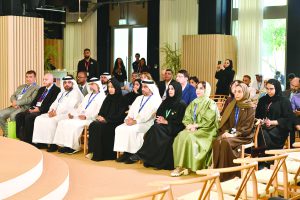DUBAI/ WAM
The Ministry of Energy and Infrastructure (MoEI) and the Environment Agency – Abu Dhabi (EAD) announced the launch of the first hydrogeological map and geo-database of the UAE, a milestone achievement in documenting and managing water sources with the goal of sustaining and conserving water.
The hydrogeological maps generated include all hydrogeological data, such as groundwater well locations, geology, geomorphology, dams, springs, groundwater quality, and meteorological data. These maps were made with different scales for both regional and local views. This further facilitates taking appropriate measures and forming policies to exploit these aquifers sustainably using available groundwater resources, protecting them from depletion and pollution, and optimally planning for more effective land use.
These maps are unique, representing a comprehensive hydrogeological geo-database for the UAE. The data sets are Geographical Information System (GIS) based, significantly contributing to hydrogeology.
Suhail bin Mohammed Al Mazrouei, Minister of Energy and Infrastructure, said, “The hydrogeological map of the UAE is an effective tool in the hands of policy and decision makers as they develop and implement sustainable water management practices, specifically tailored for the UAE.”
He added, “The hydrogeological maps serve the objectives of the UAE Water Security Strategy 2036, including the reduction of water scarcity and increasing water productivity, aiming for the reduction of the total water demand by 21 percent, the reuse of 95 percent of treated water, and the conservation of groundwater resources. More importantly, the Strategy will contribute to the reduction of more than 100 million tonnes of CO2 emissions from desalination plants, demand management, and conservation measures.
“The UAE faces considerable challenges when it comes to managing its water sources given the harsh geographic and climatic conditions. Through investing in modern technologies and advanced research and the development of ambitious strategies, we are committed to preserving this life-sustaining resource for generations to come. We thank our partners at the Environment Agency Abu Dhabi for joining forces with us in this undertaking that we are confident will go a long way in supporting our water security goals.”
Dr. Shaikha Al Dhaheri, Secretary-General of EAD, said, “For over four years, we collaborated with MoEI to develop the Hydrogeological Map. We curated, categorised, and analysed the data available for ground and surface water, then used geographic information systems to interpret the data and identify gaps. Meeting the increasing water demand for all consuming sectors is a challenge that requires inclusive response. We made sure the Hydrogeological Map is a reliable reference for decision makers to help them make informed decisions and preserve our precious water sources.”
The UAE’s total water demand is 5 billion m3 / year, supplied from various sources of water in the country, including groundwater at 46 percent, desalinated seawater at 42 percent, treated wastewater at 11 percent, and surface water at 1 percent.
 The Gulf Time Newspaper One of the finest business newspapers in the UAE brought to you by our professional writers and editors.
The Gulf Time Newspaper One of the finest business newspapers in the UAE brought to you by our professional writers and editors.
